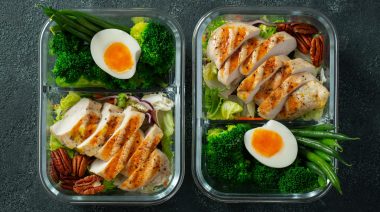Athletes talk a lot about macronutrients. From the ideal macronutrient ratio to the role of protein in muscle development, you hear a lot about the best way to eat to gain muscle, avoid fatigue, and recover from your workouts with the help of macronutrients. Here are a few common macronutrient-related mantras you’ve probably heard before:
- If you want to gain muscle, eat lots of protein. But make sure it’s lean protein.
- Food sources aren’t too important. Justget the right protein, carb, and fat ratio, and it doesn’t really matter how you get your macros and micros, as long as you get them.
- Fat is good, as long as it comes from avocados and nuts. Animal fat clogs your arteries.
Although sports nutrition is an endless and ever-changing topic, I think it’s safe to say a lot of these ideas are still considered to be sound advice for athletes. Nevertheless, it also seems the tide has turned in a new direction – the “Modern Day Caveman.” For whatever reason, people are intrigued by the idea of eating like our less civilized ancestors. More and more, people are looking to our ancestors for advice about how to eat and stay healthy, and this applies to the fitness world as well.
My own family has made a similar turn through the years. Five years ago I wouldn’t have believed it if you’d said my pantry would be free of pasta and there would be no Ben and Jerry’s in my freezer, but life had other things in store for me. About four years ago, before I even discovered the paleo diet, I stumbled across a book called Nourishing Traditions at a used book store. That book, later combined with the paleo diet, totally changed my family’s approach to food. Now I find myself doing strange things I never would have imagined, like soaking steel cut oatmeal for my daughters to eat in the morning, salivating over roasted beets, and drinking raw milk.
It always seemed to me that the diet advocated in Nourishing Traditions and by the Weston A. Price Foundation (WAPF) is particularly well-suited for many athletes. In my own experience eating the foods advocated by WAPF, I have notably higher energy levels than my old diet, which consisted primarily of processed grains, industrial dairy products, legumes, and fruit. It makes sense that a diet rich in foods eaten by our less sedentary ancestors would contribute to healthy energy levels and improved recovery.
So I figured, who better to talk with about this than Sally Fallon Morell, author of Nourishing Traditions and President of the Weston A. Price Foundation. Although her work and the Weston A. Price website might not be specifically geared to athletes, Sally noted that Weston A. Price “often commented on the athletic prowess of these traditional peoples.” For example, in one Swiss village he noted that fresh cream was known as an ideal food for athletes. Personally, I can handle the idea of fresh cream as a workout aid.

If you’re at all familiar with Sally’s book, you can probably anticipate that her advice for athletes is far from stereotypical. In the same way that Nourishing Traditions is self-admittedly politically incorrect, Sally’s advice for athletes is hardly mainstream, so brace yourself. Let’s start with that magical macronutrient ratio I mentioned earlier.
Here’s what Sally had to say about these elusive percentages. “Talking about magic ratios – you don’t want more than 20% of calories as protein. 20% is quite appropriate for athletes. 20-30% carbs, and the rest of your diet should be fats. Some people do better on a diet that’s 60-70% fat.” You probably noticed one big glaring difference between standard nutrition advice and Sally’s – that is a lot of fat. And when Sally says “fat,” she’s not just talking about guacamole and coconut oil.
When I talk about fat, I’m talking about animal fats. I’m not talking about olive oil. I’m talking about butter, lard, and tallow. The next best fats are coconut oil and unrefined palm oil, and then next, olive oil. I use olive oil on salads so I don’t use a lot, but I mostly use lard. It’s a stable fat and it’s full of vitamin D. But most of the fats you eat should be animal fats.
In traditional cultures, animal fat was a staple diet item, according to Sally, and one of the primary ways they got it was by eating organ meats. “Traditional cultures were eating these organ meats every day, and not just liver. They were eating brain, and tongue, and kidney, and so forth. We just don’t eat those things. They really valued the fats. There’s this myth that grass-fed animals are lean…Traditional cultures never ate the lean meats – they always ate the meat with the fat.”
Of course, modern nutrition advice usually places carbs at the top of the triangle, with grains and legumes being the primary carb sources. To my mind, this is one of the most important aspects that sets the Weston A. Price diet apart from both mainstream advice and other diets, such as the paleo diet. Said Sally:

Right now it’s very fashionable to be against grains and legumes, for example with the paleo diet. With the exception of peoples in the Arctic – and I would also say people in the Tropics, because they had things like yams and sweet potatoes and bananas – but throughout temperate regions, Africa, Americas, Europe, Asia – all these cultures had grains and legumes. They were prepared properly to neutralize the anti-nutrients to make them digestible. These are great foods to have in the diet.
Unlike many other ancestral diets, Sally did not advocate eliminating grains and legumes, but she did emphasize that they need to be not only prepared properly to optimize digestion. Additionally, for best results, you should serve your grains with – you guessed it! – a source of animal fat.
Once again, they [grains] are also great vehicles for animal fats. I think of the typical American food, which was succotash, which was a combination of corn, beans, dog meat, and bear fat. Animals, grains, legumes, and of course also the fat – and bear fat is an extremely healthy fat, considered a sacred food. So that’s a good guide for us – not to be saying what we can’t eat, but to include all these foods in our diet. When it comes to grains and legumes, they need to be soaked and properly prepared.
So what about protein, often considered to be the athletic gold standard of macronutrients? Not to mention the athlete’s preferred form of protein, protein powder? Stay tuned for next week’s article on Sally’s stance on protein powder, as well as other favorite supplements like fish oil and vitamin D.






